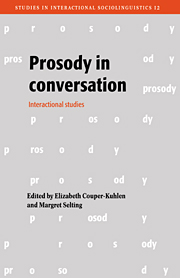Book contents
- Frontmatter
- Contents
- List of contributors
- Foreword by John J. Gumperz
- Introduction
- 1 Towards an interactional perspective on prosody and a prosodic perspective on interaction
- 2 On the prosody and syntax of turn-continuations
- 3 Ending up in Ulster: prosody and turn-taking in English dialects
- 4 Affiliating and disaffiliating with continuers: prosodic aspects of recipiency
- 5 Conversational phonetics: some aspects of news receipts in everyday talk
- 6 Prosody as an activity-type distinctive cue in conversation: the case of so-called ‘astonished’ questions in repair initiation
- 7 The prosodic contextualization of moral work: an analysis of reproaches in ‘why’-formats
- 8 On rhythm in everyday German conversation: beat clashes in assessment utterances
- 9 The prosody of repetition: on quoting and mimicry
- 10 Working on young children's utterances: prosodic aspects of repetition during picture labelling
- 11 Informings and announcements in their environment: prosody within a multi-activity work setting
- Subject index
- Index of names
3 - Ending up in Ulster: prosody and turn-taking in English dialects
Published online by Cambridge University Press: 24 November 2009
- Frontmatter
- Contents
- List of contributors
- Foreword by John J. Gumperz
- Introduction
- 1 Towards an interactional perspective on prosody and a prosodic perspective on interaction
- 2 On the prosody and syntax of turn-continuations
- 3 Ending up in Ulster: prosody and turn-taking in English dialects
- 4 Affiliating and disaffiliating with continuers: prosodic aspects of recipiency
- 5 Conversational phonetics: some aspects of news receipts in everyday talk
- 6 Prosody as an activity-type distinctive cue in conversation: the case of so-called ‘astonished’ questions in repair initiation
- 7 The prosodic contextualization of moral work: an analysis of reproaches in ‘why’-formats
- 8 On rhythm in everyday German conversation: beat clashes in assessment utterances
- 9 The prosody of repetition: on quoting and mimicry
- 10 Working on young children's utterances: prosodic aspects of repetition during picture labelling
- 11 Informings and announcements in their environment: prosody within a multi-activity work setting
- Subject index
- Index of names
Summary
Introduction
Although great strides have been made recently in the phonetic analysis of prosodic features as a result of technological developments, the advances in phonological analysis have arguably been less impressive, at least with respect to the phonology of intonation systems. This is evident if one considers a traditional concern of phonologists: the comparison of related languages or dialects. A great deal of work has been done on comparative phonology at the segmental level, and a good deal also on comparing lexical tone, stress and accent, yet there is strikingly little published research that systematically compares the intonational systems of related languages, dialects or accents. For example, in John Wells' compendious study of English accents, intonation is given little space (Wells 1982). Cruttenden (1986) notes that, although there have been scattered individual studies of different accents, these have not been used as a basis for systematic comparative work. This is somewhat surprising, given the increasing recognition, within the world of speech technology as well as more traditional applications of linguistics, that prosodic features of intonation are centrally involved in the comprehension of speech and the management of conversational interaction. Surely the ability to handle dialectal prosodic variation will be a sine qua non of a successful speech recognition system, and, one would hope, of an acceptable speech synthesis system too.
This omission is not happenstance, but derives from a general unwillingness on the part of linguists to treat ‘intonation’ with due phonological respect. In particular, there has been a failure to recognize the importance of warranting, from the observable behaviour of naive native speakers, the functional categories that intonational features are held to be exponents of.
- Type
- Chapter
- Information
- Prosody in ConversationInteractional Studies, pp. 101 - 130Publisher: Cambridge University PressPrint publication year: 1996
- 37
- Cited by

